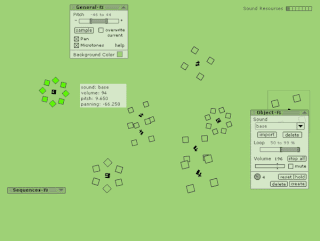 | |
| Developer(s) | ixi software |
|---|---|
| Operating system | Mac OS X |
| Type | experimental music, software |
| Website | www |
ixiQuarks is an experimental music software released by the ixi software team, focusing on both live and studio production contexts.
Experimental music is a general label for any music that pushes existing boundaries and genre definitions. Experimental compositional practice is defined broadly by exploratory sensibilites radically opposed to, and questioning of, institutionalized compositional, performing, and aesthetic conventions in music. Elements of experimental music include indeterminate music, in which the composer introduces the elements of chance or unpredictability with regard to either the composition or its performance. Artists may also approach a hybrid of disparate styles or incorporate unorthodox and unique elements.

ixi software is an open source experimental project concerned with building musical instruments where the interface is at the same time a meta-composition. The instrument becomes a pattern generator suitable for the performance of generative music. ixi runs a label as well where music is released under the Creative Commons license.
ixiQuarks is a software environment designed for live musical improvisation that allows for user interaction on hardware, GUI and code level. [1] The environment enables innumerable setups with flexible loading of tools and instruments. The ixiQuarks consist of different types of tools: basic utilities, instruments, effects, filters, spectral effects and generators.

Musical improvisation is the creative activity of immediate musical composition, which combines performance with communication of emotions and instrumental technique as well as spontaneous response to other musicians. Sometimes musical ideas in improvisation are spontaneous, but may be based on chord changes in classical music and many other kinds of music. One definition is a "performance given extempore without planning or preparation." Another definition is to "play or sing (music) extemporaneously, by inventing variations on a melody or creating new melodies, rhythms and harmonies." Encyclopædia Britannica defines it as "the extemporaneous composition or free performance of a musical passage, usually in a manner conforming to certain stylistic norms but unfettered by the prescriptive features of a specific musical text. Improvisation is often done within a pre-existing harmonic framework or chord progression. Improvisation is a major part of some types of 20th-century music, such as blues, jazz, and jazz fusion, in which instrumental performers improvise solos, melody lines and accompaniment parts.
In 2008, ixiQuarks won the first prize in the Lomus international music software contest [2] organized by the Association Française d’Informatique Musicale. [3]
This software is written in SuperCollider and is part of an extended research programme exploring human-computer interaction in computer music.
SuperCollider is an environment and programming language originally released in 1996 by James McCartney for real-time audio synthesis and algorithmic composition.






